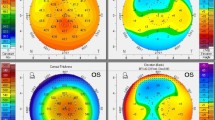Abstract
The aim of this study is to establish and to prove a new lenticule shape for the treatment of hyperopia using a 500 kHz femtosecond laser and the femtosecond lenticule extraction (ReLEx® FLEx) technique. Improved lenticule shapes with a large transition zone of at least 2 mm adjusted to the 5.75 mm optical zone were designed. A prospective pilot study on nine eyes of five patients who underwent an uncomplicated FLEx using VisuMax® femtosecond laser (Carl Zeiss Meditec AG) for spherical hyperopia was performed. Patients’ mean age was 55.5 years, and the preoperative manifest spherical equivalent (SE) was +1.82 D (range +1.25 to +3.00 D). Because of the presbyopic age and in order to compensate for a possible regression, the treatment was aimed at low myopia (mean target SE was −0.88 D with a mean treatment refraction of +2.69 D). At the last follow-up, after 9 months, 33 % were within ±0.50 D and 78 % within ±1.00 D of intended correction. Thirty-three percent lost one line, and 11 % gained one line corrected distance visual acuity (CDVA). On average, the centre of the optical zone was 0.34 ± 0.17 mm from the corneal vertex. No adverse effects were observed. This pilot study confirms that the improved lenticule’s design with a large optical and transition zone can achieve good centration and acceptable results for spherical hyperopia using FLEx. The next steps are to extend the study to spherocylindrical hyperopic treatments and to increase the number of eyes for better assessment of refractive outcome.





Similar content being viewed by others
References
Sekundo W, Kunert K, Russmann C, Gille A, Bissmann W, Stobrawa G, Sticker M, Bischoff M, Blum M (2008) First efficacy and safety study of femtosecond lenticule extraction for the correction of myopia. J Cataract Refract Surg 34:1513
Sekundo W, Kunert KS, Blum M (2011) Small incision corneal refractive surgery using the small incision lenticule extraction (SMILE) procedure for the correction of myopia and myopic astigmatism: results of a 6 month prospective study. Br J Ophthalmol 95:335–339
Shah R, Shah S, Sengupta S (2011) Results of small incision lenticule extraction: all-in-one femtosecond laser refractive surgery. J Cataract Refract Surg 37:127–137
Reinstein DZ, Archer TJ, Gobbe M (2014) Small incision lenticule extraction (SMILE). History, fundamentals of a new refractive surgery technique and clinical outcomes. Eye and Vision 1:3 (http://www.eandv.org/content/1/1/3). Accessed 28 Aug 2015
Blum M, Kunert KS, Voßmerbäumer U, Sekundo W (2013) Femtosecond lenticule extraction (ReLEX) corrections for hyperopia—first results. Graefes Arch Clin Exp Ophthalmol 251:349–355
de Ortueta D, Arba Mosquera S, Baatz H (2009) Aberration-neutral ablation pattern in hyperopic LASIK with the ESIRIS laser platform. J Refract Surg 25:175–184
Kanellopoulos AJ (2012) Topography-guided hyperopic and hyperopic astigmatism femtosecond laser-assisted LASIK: long-term experience with the 400 Hz eye-Q excimer platform. Clin Ophthalmol 6:895–901
Reinstein DZ, Couch DG, Archer TJ (2009) LASIK for hyperopic astigmatism and presbyopia using micro-monovision with the Carl Zeiss Meditec MEL80 platform. J Refract Surg 25:37–58
Reinstein DZ, Archer TJ, Gobbe M (2013) Improved effectiveness of transepithelial PTK versus topography-guided ablation for stromal irregularities masked by epithelial compensation. J Refract Surg 9:526–533
Vinciguerra P, Roberts CJ, Albé E, Romano MR, Mahmoud A, Trazza S, Vinciguerra R (2014) Corneal curvature gradient map: a new corneal topography map to predict the corneal healing process. J Refract Surg 30:202–207
Reinstein DZ, Archer TJ, Gobbe M, Silverman RH, Coleman DJ (2010) Epithelial thickness after hyperopic LASIK: three-dimensional display with Artemis very high-frequency digital ultrasound. J Refract Surg 26:555–564
Reinstein DZ, Gobbe M, Archer TJ (2013) Coaxially sighted corneal light reflex versus entrance pupil center centration of moderate to high hyperopic corneal ablations in eyes with small and large angle kappa. J Refract Surg 29:518–525
Waring GO 3rd, Reinstein DZ, Dupps WJ Jr, Kohnen T, Mamalis N, Rosen ES, Koch DD, Obstbaum SA, Stulting RD (2011) Standardized graphs and terms for refractive surgery results. J Refract Surg 27:7–9
Sales C, Manche E (2014) One-year eye-to-eye comparison of wavefront-guided versus wavefront-optimized laser in situ keratomileusis in hyperopes. Clin Ophthalmol 8:2229–2238
Lazaridis A, Droutsas K, Sekundo W (2014) Topographic analysis of the centration of the treatment zone after SMILE for myopia and comparison to FS-LASIK: subjective versus objective alignment. J Refract Surg 30:680–686
Author information
Authors and Affiliations
Corresponding author
Ethics declarations
This prospective study was approved by the Ethics Committee of the Chamber of Physicians of Thuringia, Germany, as well as by the Institutional Review Board of the Philipps University of Marburg, Germany. The Ethics Committees recommended to divide the study in a pilot study with 10 eyes (initial spherical cohort) and to proceed with a larger study (40 eyes, second, spherocylindrical cohort) only after the first treatment group has been followed up and reported appropriately. An informed consent was obtained from each patient.
Conflict of interest
This study was supported by Carl Zeiss Meditec AG, Jena, Germany. Professor Reinstein is a consultant for Carl Zeiss Meditec AG and has a financial interest in the Artemis technology (ArcScan Inc, Morrison, CO). Professor Sekundo is a Member of the Scientific Advisory Board of Carl Zeiss Meditec AG, Jena, Germany. Professors Blum and Sekundo received honoraria from Carl Zeiss Meditec for corporate presentations in the past. The authors certify that they have no other affiliations (except from the above mentioned) with or involvement in any organization or entity with any financial interest (such as honoraria; educational grants; participation in speakers’ bureaus; membership, employment, consultancies, stock ownership, or other equity interest; and expert testimony or patent-licensing arrangements), or non-financial interest (such as personal or professional relationships, affiliations, knowledge or beliefs) in the subject matter or materials discussed in this manuscript.
Rights and permissions
About this article
Cite this article
Sekundo, W., Reinstein, D.Z. & Blum, M. Improved lenticule shape for hyperopic femtosecond lenticule extraction (ReLEx® FLEx): a pilot study. Lasers Med Sci 31, 659–664 (2016). https://doi.org/10.1007/s10103-016-1902-2
Received:
Accepted:
Published:
Issue Date:
DOI: https://doi.org/10.1007/s10103-016-1902-2




